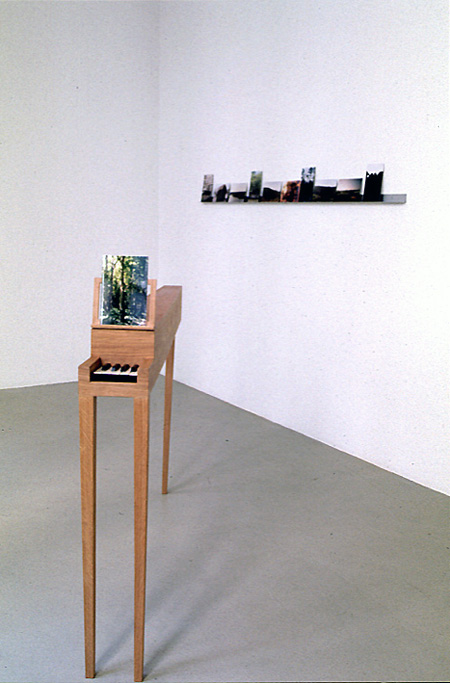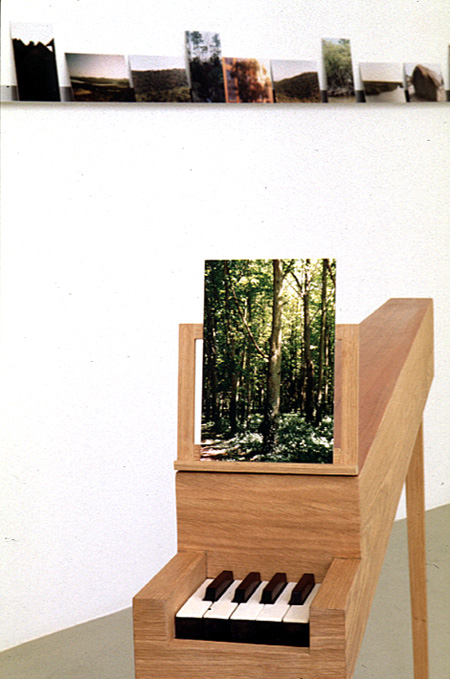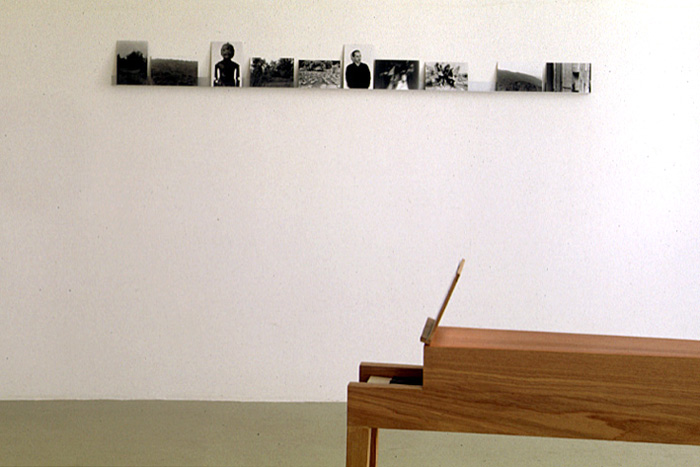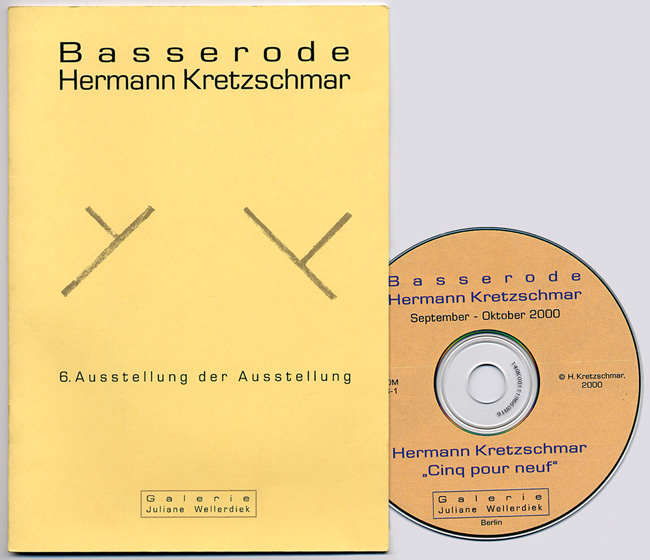 |
Partitions 2000
Clavecins en bois de chêne, ebène, os réalisés avec le facteur d’orgues Pascal Gourrat,
109,5 x 150 x 18,2 cm
9 photographies 13x18 cm chacune
Photographies courtesy Galerie Nelson
Harpsichords in oak, ebony, bone realized with the organ-maker Pascal Gourrat,
109,5 x 150 x 18,2 cm
9 photographs 13x18 cm each
|
L’installation Partitions montrée dans la 6ème exposition de l’exposition se compose de deux objets qui ressemblent formellement à un fragment de piano à queue mais dont la technique musicale est celle d’un clavecin. Chacun de ces clavecins dispose d’un clavier de 9 touches (5 blanches et 4 noires en alternance). Ces touches déterminent par leur sonorité inhabituelle la situation de jeu initiale. Font office de partition deux séries de 9 photographies chacune, représentant divers motifs de l’environnement naturel et urbain. Le spectateur peut prendre pour partition un motif de son choix parmi les photographies, le poser sur le support prévu à cet effet et commencer à jouer. La mémoire déclenchée visuellement peut alors s’exprimer musicalement par le jeu du spectateur sur le clavecin.
Pour présenter les séries de photos, Basserode s’est servi des éléments sculpturaux et architecturaux à sa disposition. Il les a installés dans un rapport de tension avec les clavecins. La position des objets de présentation et des clavecins dynamisent l’espace d’exposition et trouvent prolongement et résonance dans la dynamique de la musique de Kretzschmar et dans la dynamique de l’idée de nomadisme chez Basserode.
Juliane Wellerdiek, 2000
The installation Partitions, shown in the 6th chapter of the exhibition comprises two objects that formally resemble a fragment of a grand piano but use the musical technique of a harpsichord. Each harpsichord has a keyboard that counts 9 keys ( 5 white, 4 black, in alternation). The unusual sound of these keys determines the initial playing situation. Two series of 9 photographs act as partitions, representing various motifs from the natural and urban environment. The spectator can use the motif of his choice from the photographs as a partition, sit it on the intended stand and begin playing. The visually activated memory can thus express itself musically through the spectator’s playing the harpsichord. Basserode chose to use the sculptural and architectural elements at his disposal to present the photographs. He installed them so that their placement in relation to the harpsichords would produce a certain tension. The dynamism conferred upon the exhibition space by the position of the objects presented and the harpsichords finds an extension and resonance in Kretzschmar’s music and Basserode’s nomadism.
Juliane Wellerdiek, 2000
|
 |
 |
Partitions 2000
Clavecins en bois de chêne, ebène, os réalisés avec le facteur d’orgues Pascal Gourrat,
109,5 x 150 x 18,2 cm
9 photographies 13x18 cm chacune
Photographies courtesy Galerie Nelson
Harpsichords in oak, ebony, bone realized with the organ-maker Pascal Gourrat, 109,5 x 150 x 18,2 cm
9 photographs 13x18 cm each
|
 |
Livret CDROM
Hermann Kretzschmar est pianiste à l’Ensemble Modem de Francfort/Main et compositeur pour le label HCD
CDROM libretto
Hermann Kretzschmar is a pianist for the Modern Ensemble of Frankfurt/Main and a composer on the HCD label
Retour |
|
|
|